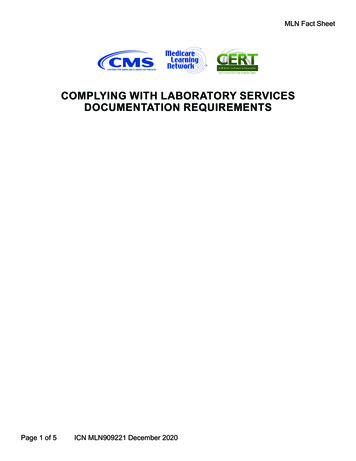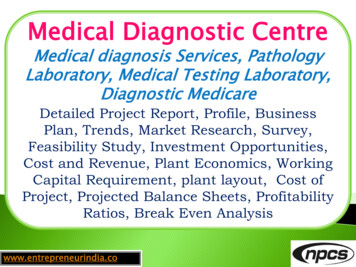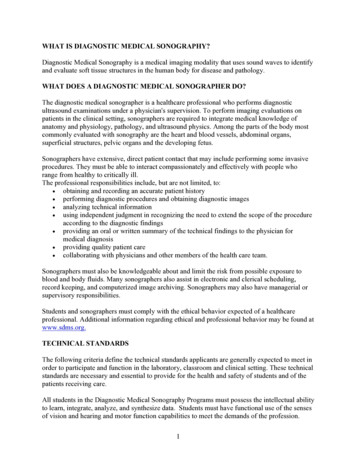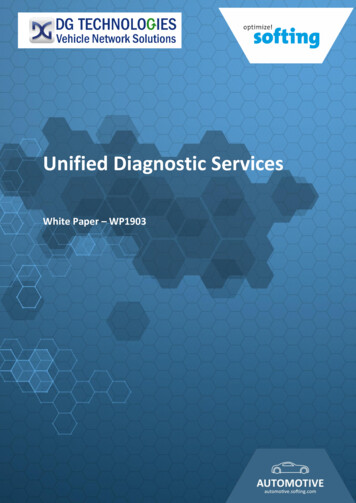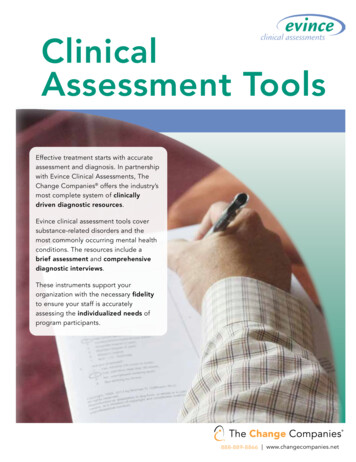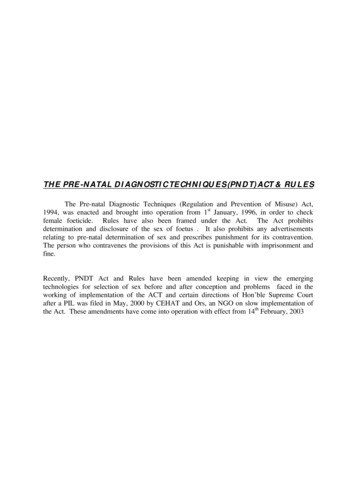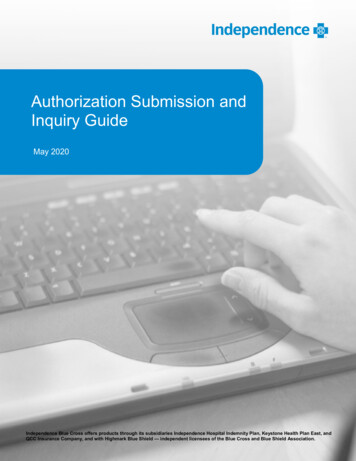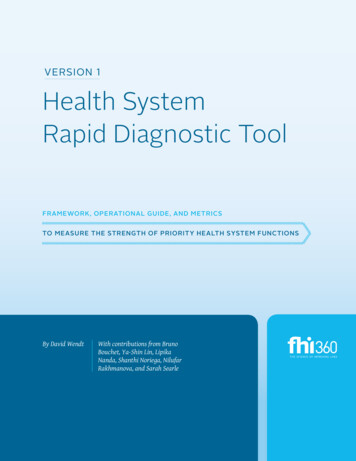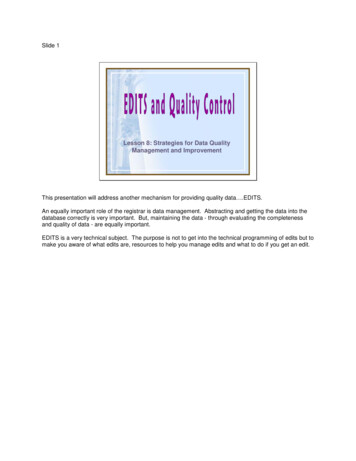
Transcription
DPIA Office 365 ProPlus version 1905 (June 2019)Data protection impact assessment on the processing ofdiagnostic dataVersion 1DateStatus22 July 2019Public
DPIA Office 365 ProPlus version 1905, 22 July 2019ColofonDPIA byMinistry of Justice and SecurityStrategic Vendor Management Microsoft(SLM Rijk)Turfmarkt 1472511 DP The HaguePO Box 203012500 EH The Haguewww.rijksoverheid.nl/jenvContactPaul van den BergE p.j.van.den.berg@minvenj.nlT 070 370 79 11Project nameDPIA report diagnostic data processing in Microsoft Office365 ProPlus version 1905Appendices1 Overview telemetry data observed at the levels ‘required’and at level ‘neither’2 List of categories of data subjects and personal dataAuthorsPrivacy ,senioradvisorsPage 3 of 102
DPIA Office 365 ProPlus version 1905, 22 July 2019ContentsSummary 7Introduction 11Part A. Description of the Office diagnostic data processing 161. The processing of diagnostic data 161.1 About Microsoft Office 365 ProPlus and Connected Experiences 181.2 Scope 192. Personal data and data subjects 212.1 Personal data 212.1.1 Technical analysis telemetry data 232.1.2 Ability to combine events over time 312.1.3 Ability to use the diagnostic data for analytical services 322.2 Possible types of personal data and data subjects 342.2.1 Categories of personal data 342.2.2 Categories of data subjects 363. Data processing through diagnostic data 373.1 Anonymisation and pseudonymisation 393.2 Privacy choices in Office 365 ProPlus 394. Purposes of the processing 474.1 Results of negotiations purpose limitation with Microsoft 494.2 Purposes Controller Connected Experiences 514.2.1 Purpose: compatible uses with providing the service 514.2.2 Purpose: Provide Our Products 514.2.3 Purpose: Product improvement 524.2.4 Purpose: Personalisation 524.2.5 Purpose: Product Activation 524.2.6 Purpose: Product Development 524.2.7 Purpose: Help secure and troubleshoot 524.2.8 Purpose: Safety 524.2.9 Purpose: Updates 534.2.10 Purpose: Relevant Offers 534.2.11 Purpose: Advertising 534.2.12 Purpose: Reporting and Business Operations. 534.2.13 Purpose: Protecting rights and property. 544.2.14 Purpose: Research. 545. Controller, processor and sub-processors 545.1 Results of negotiations Microsoft as data processor 565.2 Microsoft as data controller for the optional Connected Experiences 596. Interests in the data processing 607. Transfer of personal data outside of the EU 628. Techniques and methods of the data processing 659. Additional legal obligations: ePrivacy Directive 6810. Retention Period 68Part B. Lawfulness of the data processing 7411. Legal Grounds 7411.1 Consent 7411.2 Processing is necessary for the performance of a contract 7511.3 Processing is necessary to comply with legal obligation 77Page 5 of 102
Titel 18 februari 201911.4 Processing is necessary for the public interest 7711.5 Processing is necessary for the legitimate interests of the controller or a thirdparty 7812. Special categories of personal data 7913. Purpose limitation 8114. Necessity and proportionality 8214.1 The principle of proportionality 8214.2 Assessment of the proportionality 8314.3 Assessment of the subsidiarity 8515. Rights of Data Subjects 86Part C. Discussion and Assessment of the Risks 8916. Risks 8916.1Identification of Risks 8916.1.1 Metadata 8916.1.2 Content 9116.2Assessment of Risks 9216.2.1 Lack of transparency 9216.2.2 Lack of control 9316.2.3 Sensitive nature of the metadata and content 9316.2.4 Microsoft does not act as a data processor for some of the ConnectedExperiences 9316.2.5 Not enough control over sub-processors and factual processing 9316.2.6 No purpose limitation 9516.2.7 Long retention period 9516.2.8 Processing of personal data outside of the EEA 9516.3 Summary of low risks 99Part D. Description of risk mitigating measures 10017. Risk mitigating measures 10017.1Measures Microsoft 10017.2Measures government organisations 101Conclusions 102Page 6 of 102
DPIA Office 365 ProPlus version 1905, 22 July 2019SummaryIn May 2019, the Dutch government has commissioned a new Data Protection ImpactAssessment (DPIA) on the processing of data about the use of the Microsoft Office365 ProPlus software. This DPIA assesses the progress with commitments made byMicrosoft after the first DPIA, published in November 2018. This report provides atechnical analysis of the data about the usage of the new Office 365 ProPlus softwareversion 1905 released by Microsoft on 11 June 2019. In a separate DPIAsimultaneously published with this report, the risks are analysed of the use of OfficeOnline and the mobile Office apps.Results: No more high data protection risksThe outcome of this DPIA on Office 365 ProPlus is that Microsoft and the Dutchgovernment have managed, through a combination of technical, contractual andorganisational measures, to mitigate the eight high data protection risks from the firstDPIA. These high risks were mostly due to a lack of transparency, a lack of purposelimitation and legal ground, lack of clarity about the role of Microsoft as data processoror as data controller, and the transfer of usage data, including contents of documents,to the United States while there was a lack of effective control mechanisms. If theadministrators of Office 365 ProPlus follow the advice from this DPIA and, amongstothers, set the telemetry to Neither and turn off the Controller ConnectedExperiences, there are no more known high data protection risks for data subjectsrelated to the collection of data about the use of Microsoft Office 365 ProPlus.Use by 300.000 government employeesThe Office software is deployed on a large scale by different governmentalorganisations, such as ministries, the judiciary, the police and the taxing authority.Approximately 300.000 government employees work with the software on a dailybasis, to send and receive e-mails, create documents and spreadsheets and preparevisual presentations. Generally, these organisations store the content they producewith the Office software in governmental data centres, on premise. Since the Dutchgovernment currently tests the use of the online SharePoint and OneDrive forBusiness cloud storage facilities, this DPIA also includes the use of these cloud storageservices. This DPIA also includes the use of the so called Connected Experiences.Those are online services that are closely integrated with the Office software, such asthe spelling checker (Editor), the translator module and the possibility to includepictures from the internet.Umbrella DPIA versus individual DPIAsNegotiations with Microsoft were conducted by the Microsoft Strategic VendorManagement office (SLM Rijk Microsoft). However, the individual governmentorganisations buy the licenses and determine the settings and scope of the processingby Microsoft Corporation in the USA. Therefore this general DPIA can help the differentgovernment organisations with the DPIAs they must conduct, but this document doesnot replace the specific risk assessments the different government organisations mustmake. Only the organisations themselves can assess the specific data protection risks,based on their specific deployment, the level of confidentiality of their work and thetypes of personal data they process.Scope: diagnostic data, not functional dataThis report addresses the data protection risks of the storing by Microsoft of dataabout the individual use of the Office 365 ProPlus software, including the use ofPage 7 of 102
Titel 18 februari 2019Connected Experiences and cloud storage services. These metadata (about the use ofthe services and software) are called ‘diagnostic data’ in this report.Technically, Microsoft Corporation collects diagnostic data in different ways, viasystem-generated event logs on its own servers and via the Office telemetry client.Similar to the telemetry client in Windows 10, Microsoft has programmed the Officesoftware to collect telemetry data on the device, and regularly send these toMicrosoft’s servers in the USA.The diagnostic data are different from the data that users provide to Microsoft suchas content data, and they are also different from the functional data that Microsofthas to temporarily process to allow users to connect to the internet and use Microsoft’sonline services.Technical and organisational measures to mitigate risksIn little over six months Microsoft has implemented important technical andorganisational measures to mitigate or lower the data protection risks found for Office365 ProPlus in the first DPIA.Since May 2019, Microsoft has published extensive documentation about the OfficeProPlus telemetry data. Microsoft has also modified the data viewer tool for Windows10 telemetry events to also show the Office 365 ProPlus telemetry events. This allowsdata subjects to see the decoded Office ProPlus telemetry data Microsoft collects.Since May 2019, Microsoft offers the most widely used and indispensable ConnectedExperiences such as the Editor (spelling checker), Translator and Office Help from arole as data processor, in stead of as data controller. There are 14 remainingController Connected Experiences. Microsoft allows administrators of Office ProPlus tocentrally turn off these Controller Connected Experiences. This prevents the risk thatemployees are shown a question to provide consent for these services, while consentis not a valid legal ground for this data processing.Microsoft optional Controller Connected Experiences3D MapsResearcherInsert online 3D ModelsSmart LookupMap ChartInsert Online PicturesOffice StoreLinkedIn Resume AssistantInsert Online VideoWeather Bar in OutlookPowerPoint QuickStarterGiving Feedback to MicrosoftResearchSuggest a FeatureSince version 1904, released 29 April 2019, Microsoft also offers choices foradministrators to minimise the amount of diagnostic data. Microsoft provides threeoptions: Required, Optional and Neither.The technical analysis of the diagnostic data collected at the levels of Required andNeither shows that the data do not contain any content from documents, emails orconversations, and no directly identifying data such as user names or e-mailaddresses. The events related to the use of the processor Connected Experiences suchas the spelling checker and Translator also do not contain snippets of content.At the level ‘Neither’ Microsoft collects similar types of data as at the Required level,in spite of the claim that no diagnostic data about Office client software running onthe user’s device is sent to Microsoft. Some of the events at the ‘Required’ levelcontain more sensitive information, such as the exact number of pages, paragraphs,Page 8 of 102
DPIA Office 365 ProPlus version 1905, 22 July 2019lines, words, characters, spaces, pictures and citations in a Word document, as wellas the interaction time in milliseconds that the data subject was actively interactingwith the document.In response to these findings, Microsoft has explained that there are two kinds ofdiagnostic data that are always collected and are not influenced by the new diagnosticdata choice: required service data about the use of the Connected Experiences anddiagnostic data about Essential Services such as authentication, telemetry and licensechecks. Both categories are also shown in the Data Viewer Tool.Contractual improvements to mitigate risksMicrosoft has included a number of contractual privacy guarantees in the enrolmentcontract with the Dutch government. These guarantees ensure purpose limitation andthe possibility for the Dutch government to verify compliance through effective auditrights. Microsoft has also contractually committed to its new role as data processorfor most of the Connected Experiences.As a data processor for the processing of usage data about Office 365 ProPlus, mostof the Connected Experiences and cloud storage services, Microsoft acknowledges thatit processes personal data through the metadata and will only process these data forthree authorised purposes, and only where proportional. These purposes are: (1) toprovide and improve the service, (2) to keep the service up-to-data and (3) secure.This strict purpose limitation applies to both the content (Customer Data) and to alldiagnostic data, including the system-generated server logs. Microsoft hasadditionally guaranteed that it won’t use the content data or the diagnostic data forthe purposes of profiling, data analytics, market research or advertising, unless thecustomer explicitly requests Microsoft to do so. This includes a specific prohibition onthe use of diagnostic data to show ‘tips’ or recommendations for the use of Microsoftsoftware and products that the customer has not purchased or does not use.The Dutch government has also obtained effective audit rights, and will have anindependent auditor perform an annual audit to verify compliance with thesemeasures. A summary of the findings will be published by SLM Rijk.Overview of implemented measures to mitigate high risksNoHigh RiskMeasures taken by Microsoft1Lack of transparencyPublic documentation and data viewer tool2No possibility for administratorsto influence the collection oftelemetry dataSince Dec 2018: temporary settings to minimisethe processingUnlawful collection and storage ofsensitive or classified categoriesof data through ConnectedExperiences and diagnostic dataon cloud servers with for examplefilenamesContractual purpose limitation: processing onlyfor three purposes for which the governmentorganisations have a legal ground3Since release of version 1904: admin choices fortelemetry levelsMicrosoft is a data processor for most ConnectedExperiences central opt-out from ControllerConnected ExperiencesMicrosoft will not use content or diagnostic datafor profiling, data analytics, market research oradvertising4Incorrect qualification Microsoftas data processorContractual purpose limitationMicrosoft is a data processor for most ConnectedExperiences central opt-outPage 9 of 102
Titel 18 februari 2019NoHigh RiskMeasures taken by Microsoft5Not enough control over subprocessors and factual processingEffective audit rights for the Dutch government tohave an annual audit performed commitment toconduct audit and publish summary of findings6Lack of purpose limitationContractual purpose limitation7Employee monitoring system:chilling effect-8Long retention period ofdiagnostic dataMicrosoft is a data processor for most ConnectedExperiences central opt-outContractual purpose limitationLimitation of future telemetry through switch9Transfer of data to the USALimitation of telemetry through switch effectiveaudit rights contractual purpose limitation. Seethe paragraphs 7 and 16.8.2 for measures thatshould be taken by the European CommissionRecommended measures for government organisationsTo mitigate the remaining data protection risks, government organisations can alsotake some measures themselves.The recommended measures are:1. Centrally prohibit the use of the Controller Connected Experiences;2. Upgrade to version 1905 or higher of Office 365 ProPlus and set the telemetrylevel to ‘Neither’. At the level ‘Required’ Microsoft collects slightly moresensitive data: the organisation needs to ensure that this data processingdoes not lead to a chilling effect amongst employees;3. Set the telemetry level in Windows 10 Enterprise to ‘Security’ (or blocktelemetry traffic) and do not allow users to synchronise activities via theTimeline functionality. At higher levels, Windows telemetry also collectsinformation about the use of Office ProPlus applications;4. Disable sending of data for Customer Experience Improvement Program5. Turn off Linked-In integration with Microsoft employee work accounts;6. Conduct a DPIA before using Workplace Analytics and Activity Reports in theMicrosoft 365 admin center and before allowing employees to use MyAnalyticsand Delve;7. Depending on the sensitivity of the content data: consider using CustomerLockbox and Customer Key;8. Warn employees not to use Office Online and the mobile Office apps that areincluded in the Office 365 license until the five high risks have been mitigated.ConclusionsAs described in the letter sent on 1 July 2019 by the minister of Justice and Securityand the minister of Interior Affairs and Kingdom Relation to members of parliament 1,Microsoft and the Dutch government have managed, through a combination oftechnical, contractual and organisational measures, to mitigate the eight high dataprotection risks from the first DPIA. If the government administrators take therecommended measures in this DPIA, as a result of the contractual and technicalimprovements there are no more known high data protection risks for data subjectsrelated to the collection of data about the use of Microsoft Office 365 n/brieven regering/detail?id 2019Z13829&did 2019D284651Page 10 of 102
DPIA Office 365 ProPlus version 1905, 22 July 2019IntroductionThis report, commissioned by the Microsoft Strategic Vendor Management office (SLMRijk2) of the Ministry of Justice and Security, is a second data protection impactassessment (DPIA) on the processing of personal data about the use of the MicrosoftOffice 365 ProPlus software. This version of the Office software is installed locally, onthe device of the users, but is used in combination with online Office 365 services.This DPIA assesses the progress with commitments made by Microsoft after the firstDPIA, published in November 2018. This DPIA provides a technical analysis of thedata about the usage of the new Office 365 ProPlus software, in version 1905 releasedby Microsoft on 11 June 2019. This DPIA also takes the results into account of tworounds of negotiations between Microsoft and the Dutch government aboutcontractual and technical improvements.DPIAUnder the terms of the General Data Protection Regulation (GDPR), an organisationmay be obliged to carry out a data protection impact assessment (DPIA) under certaincircumstances, for instance where large-scale processing of personal data isconcerned. The assessment is intended to shed light on, among other things, thespecific processing activities which are carried out, the inherent risk to data subjects,and the safeguards applied to mitigate these risks. The purpose of a DPIA is to ensurethat any risks attached to the process in question are mapped and assessed, and thatadequate safeguards have been implemented to tackle those risks.A DPIA used to be called PIA, privacy impact assessment. According to the GDPR aDPIA assesses the risks for the rights and freedoms of individuals. Data subjects havea fundamental right to protection of their personal data and some other fundamentalfreedoms that can be affected by the processing of personal data, such as for examplefreedom of expression.The right to data protection is therefore broader than the right to privacy.Consideration 4 of the GDPR explains: “This Regulation respects all fundamental rightsand observes the freedoms and principles recognised in the Charter as enshrined inthe Treaties, in particular the respect for private and family life, home andcommunications, the protection of personal data, freedom of thought, conscience andreligion, freedom of expression and information, freedom to conduct a business, theright to an effective remedy and to a fair trial, and cultural, religious and linguisticdiversity”.This DPIA follows the structure of the DPIA Model mandatory for all Dutch governmentorganisations.3Umbrella DPIA versus individual DPIAsThe Microsoft Office software is used by approximately 300.000 employees andworkers in the Dutch ministries, parliament, the High Councils of state, the advisorycommissions, the police, the fire department and the judiciary, as well as theindependent administrative authorities.4 The Microsoft Office software is not new.SLM is the abbreviation of the Dutch words Strategisch Leveranciersmanagement Microsoft.Model Gegevensbeschermingseffectbeoordeling Rijksdienst (PIA) (September 2017). For anexplanation and examples (in Dutch) rdeling-rijksdienst-pia.4Source: Microsoft Business and Services Agreement, Amendment ID CTM, May 2017, lastamended 10 May 2019.23Page 11 of 102
Titel 18 februari 2019However, because the data processing takes place on a large scale, and the dataprocessing involves data about the communication (be it content or metadata), andinvolves data that can be used to track the activities of employees, it is mandatoryfor the Dutch government organisations in the Netherlands to conduct a DPIA basedon the criteria published by the Dutch data protection authority.5In GDPR terms SLM Rijk is not responsible for the processing of diagnostic datathrough the use of the Office software. However, as central negotiator with Microsoft,it has a moral responsibility to assess the data protection risks for the employees andnegotiate for a framework contract that complies with the GDPR. Therefore, SLM Rijkcommissions umbrella DPIAs to assist the government organisations to select aprivacy-compliant deployment, and conduct their own DPIAs where necessary. Onlythe organisations themselves can assess the specific data protection risks, related tothe technical privacy settings, nature and volume of the personal data they processand vulnerability of the data subjects.This umbrella DPIA is meant to help the different government organisations with theDPIA they must conduct, but this document cannot replace the specific riskassessments the different government organisations must make.Other Microsoft DPIAs SLM RijkSimultaneously with this DPIA about Office 365 ProPlus, SLM Rijk also publishes aDPIA on the risks of the processing of diagnostic data through Office Online and themobile Office apps.The role of SLM Rijk is not limited to Microsoft Office. As representative of all theprocuring government organisations, SLM Rijk assesses the risks for all Microsoftproducts and services that are commonly used by government organisations, such asWindows, Office, Dynamics and Azure and approaches the risk mitigating measureswith a holistic view. Microsoft has been working constructively with SLM Rijk duringthe review of the risks of the use of these products.In the volume licensing agreements, Microsoft releases new versions of its Office 365ProPlus and Windows Enterprise software twice per year. As part of its ongoingcommitment to ensure GDPR compliance, SLM Rijk intends to regularly commissionnew DPIAs on new versions of Windows 10 and Office 365, to guarantee the rights ofdata subjects on ongoing basis. New DPIA’s can be necessary to examine the risks ofchanges in the technology and processing methods, to take account of modificationsof the applicable laws and/or relevant jurisprudence, and to assess changes in thecontractual agreement with Microsoft.In November 2018 SLM Rijk has published a first DPIA on the data protection risks ofthe autumn 2018 version of Office 365 ProPlus, version 1708.6 The report wasSource: Dutch DPA, (information available in Dutch only), Wat zijn de criteria van de AP vooreen verplichte DPIA?, URL: -criteria-van-de-ap-voor-een-verplichte-dpia6667. Similar criteria (data processed on a large scale, systematic monitoring and dataconcerning vulnerable data subjects and observation of communication behaviour) are includedin the guidelines on Data Protection Impact Assessment (DPIA), WP249 rev.01, from the dataprotection authorities in the EU, URL: cfm?item id 611236.6This first Office ProPlus DPIA report also assessed the risks of Office 2016 ProPlus, and waspublished on 7 November 2018, with an update on the negotiations between the Dutch centralgovernment and Microsoft about the GDPR compliance. -microsoft-office.5Page 12 of 102
DPIA Office 365 ProPlus version 1905, 22 July 2019published on the Dutch government website with an update on the negotiationsbetween the Dutch central government and Microsoft about the GDPR compliance.7Simultaneously with the DPIAs on Office 365 ProPlus, SLM Rijk has also commissioneda renewed DPIA on Windows 10 Enterprise. This new assessment on the dataprotection risks of Windows 10 Enterprise version 1809 and 1903 recommends toupdate to the 1903 version or later, and concludes that there are no high dataprotection risks when the telemetry level is set to Security, and admins prevent usersfrom syncing their activities via the Windows 10 Timeline.SLM Rijk has also commissioned DPIAs on the data processing risks of usingMicrosoft’s Azure cloud services and Microsoft Dynamics.The DPIA reports have been written by the Dutch privacy consultancy firm PrivacyCompany.8Scope: Office ProPlus with telemetry ‘Required’ and ‘Neither’Microsoft offers three telemetry settings for administrators in the new Office 365ProPlus versions 1904 and up, released since 29 April 2019: Optional, Required andNeither. This report describes the differences in data protection risks for data subjectsbetween the lowest levels of telemetry settings: Required and Neither. In this secondscenario telemetry is still being collected on the device and sent to Microsoft. Theevents observed with the data viewer were largely the same as the events observedat the Required level, but some events were added and some events excluded.This DPIA assesses the risks of data processing about the use of the five core apps(Word, Excel, Outlook, PowerPoint and Teams) in combination with the ConnectedExperiences (such as the spelling checker) and use of the Microsoft cloud storageservices SharePoint Online and OneDrive, a so called hybrid set-up.The risks of data processing at the Optional level of telemetry are outside the scopeof this DPIA. Additionally, this DPIA does not assess the data protection risks of theuse of Office 2019, Office Online or the mobile Office apps, or other software that isincluded within the government Office 365 licenses.The exact scope is detailed in paragraph A1.3 of this report.Technical analysis of the telemetry dataThis report provides an analysis of the contents of the telemetry data as collected bythe test lab created by SSC-I for the Ministry of Justice and Security in June 2019.The lab has performed a number of scripted scenario’s on Virtual Machines withWindows 10 Enterprise 1809 and Office 365 ProPlus version 1905 (Build11629.20246).9In close dialogue with Privacy Company, the technical lab has performed scriptedscenario’s on virtual machines. The scenarios were drafted to capture data fromcommon use by government employees, but they are limited in time and scope. Thescenarios involved the execution of a scripted actions in each of the five most widelyIbid.https://www.privacycompany.eu/9The lab experienced problems testing version 1904, because of the combination of Englishgroup policies while Dutch was set as the language for the OS and applications. See theMicrosoft Office update history at atehistory-office365-proplus-by-date (last visited and recorded on 8 July 2019).78Page 13 of 102
Titel 18 februari 2019used Office tools (Word, Excel, PowerPoint, Outlook and Teams). These actions wereactivities such as opening and storing a document, sending an e-mail, including apicture in a PowerPoint, and misspelling a few words in Word. In each of those apps,several Connected Experiences were used, and documents were stored and retrievedfrom SharePoint Online and OneDrive for Business.The scenarios represent the collection of diagnostic data with the telemetry set toRequired and to ‘Neither’, with the Windows 10 telemetry level set to the lowest levelof Security.The technical lab relied on the newly expanded functionality of Microsoft's DiagnosticData Viewer to detect and record the outgoing telemetry. As an essential securitymeasure, Microsoft encodes the outgoing traffic to its own servers in a way that makesinspection of the content of the traffic impossible with normal proxy-techniques. Thetechnical lab also recorded all outgoing network traffic with Network Monitor andFiddler. This setup ensures that any unexpected network traffic would be noticed. Allthe captured outgoing telemetry and traffic has been stored and provided in csvformat to Privacy Company. Additionally, the lab has recorded all settings and actionson virtual disk images and has stored these images to be able to reproduce all actionsand resulting telemetry events.The analysis of the collected telemetry data in this report is a snapshot, becauseMicrosofts collection of telemetry data is dynamic. Microsoft can add telemetry eventson the fly, and collect other types of data, if it assesses that the purposes comply withthe purposes described in this report.The details of the executed scenario’s and main findings from the technicalinvestigation are described in part A of this DPIA. Privacy Company has compared theresults with the publicly available documentation from Microsoft about the Officetelemetry data. In this documentation, Microsoft sometimes uses the word ‘obsolete’for telemetry events that may still be collected, but has been or will soon be removedfrom the diagnostic data at the Required level.Response MicrosoftSLM Rijk has asked Microsoft to comment on the technical findings with regard to thetelemetry settings of ‘Neither’ and ‘Required’, and to provide information on thedefault setting (for admins) of sending data to Microsoft for the Customer ExperienceImprovement Program (CEIP). Microsoft has replied by e-mail of 19 July 2019. Thespecific answers are included in paragraphs 2.1.1 (Technical analysis telemetry data)and 3.2 (
DPIA Office 365 ProPlus version 1905, 22 July 2019 Page 5 of 102 Contents Summary 7 Introduction 11 Part A. Description of the Office diagnostic data processing 16 1. The processing of diagnostic data 16 1.1 About Microsoft Office 365 ProPlus and Connected Experiences 18 1.2 Scope 19 2. Personal data and data subjects 21 2.1 Personal data 21
